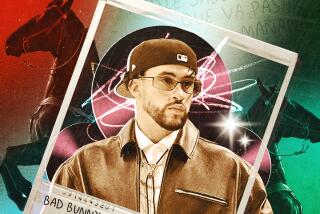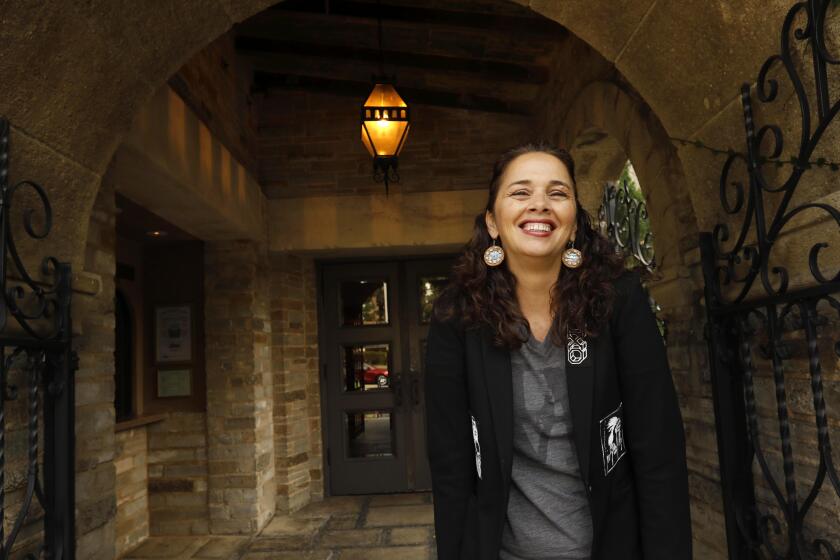Review: Finding connections at the Laguna Dance Festival
The Laguna Dance Festival is small, but it has a mighty impact, thanks to artistic director Jodie Gates and her long and impressive list of friends and contacts.
The eighth annual festival, ensconced in its new home at the Laguna Playhouse, featured Lines Ballet from San Francisco and Hubbard Street Dance Chicago on a shared headliners’ program Saturday and Sunday; Orange County’s contemporary troupe Backhausdance put on a strong 10th anniversary retrospective show Friday night.
Gates’ connections with both Lines and Hubbard Street derive from when she was a leading dancer with the Joffrey Ballet in the 1980s: Fellow dancer Glenn Edgerton is now artistic director of Hubbard Street, and Lines artistic director Alonzo King cast Gates in one of his pieces for the Joffrey. The dance world is separated by fewer than six degrees.
SPECIAL REPORT: Fall Arts Preview
The Lines-Hubbard Street pairing was fortuitous. Both companies have been at nearby UC Irvine (where Gates is an associate professor of dance) working as a combined force on a new King creation; that piece will have its local premiere at the Music Center in June 2013.
Saturday’s program gave no hint of that work. Rather, it was an even split, with Lines up first. Its 12 statuesque gods and goddesses — that is, its dancers — filled the space with their extraordinarily full style. This was King’s “Dust and Light,” a spiritually infused 2008 journey to recorded instrumental and choral selections by Francis Poulenc and Arcangelo Corelli.
“Dust and Light” unreeled via duets and trios, without narrative arc or landmarks. The dancers’ movements suggested broken characters and healers with a magical touch. King tells no story, however, and his work can be abstruse. His dancers often look down, caught in an inner whirlwind. The choreographer aims to unite the inner and outer human being in his sculptural, ballet-based dances (the women are en pointe). When that effect is achieved, there is no time but the present, and Saturday’s results were thrillingly spontaneous.
Given those heights, Lines was a hard act to follow. Hubbard Street was disadvantaged further by Ohad Naharin’s “Three to Max” (2011), which only reduced them in stature.
“Three to Max” was an unsatisfying compilation piece of past scenes stitched into a whole with a string of unnamed musical selections. The cast was buffeted in a stop-motion style, jerkily forced through repetitive cycles of stamping, jumping and mock tests. The audience was made voyeurs. The Hubbard Street men and women convincingly succumbed to the unseen forces, but Naharin diminished their abilities rather than boosting them.
On Friday, founder and choreographer Jennifer Backhaus surveyed her troupe’s first 10 years through five pieces dating back to 2003. Backhaus communicates in a straightforward kinetic fashion; she hones in precisely on meaning and emotion. Her rhythmic instincts also are sharp, and her dances flow with passion and earthiness.
Execution, however, is not always sharp or intense enough, and that was a problem on this night. The one new piece, “The Margin,” wasn’t developed enough from an earlier work that was performed on a 16-square-foot platform.
There were several successes, though, including the duet “Push” (2007), to music by Zoe Keating. Omar Olivas and Liane Aung fully embodied the yearning of a couple struggling to connect. Likewise, in “Love and Other Impossibilities” (2006), the group swayed joyfully to Pink Martini’s syncopated Latin rhythms.
More to Read
The biggest entertainment stories
Get our big stories about Hollywood, film, television, music, arts, culture and more right in your inbox as soon as they publish.
You may occasionally receive promotional content from the Los Angeles Times.






